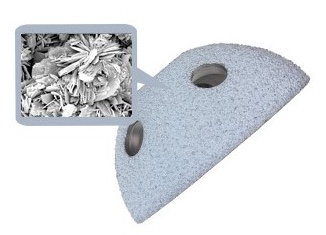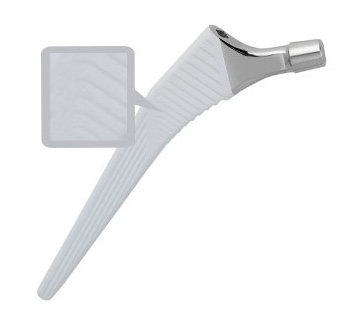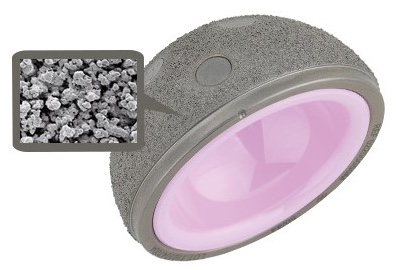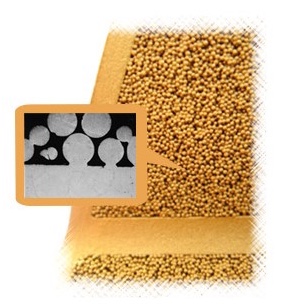
Technology
other coatings
Get informed about coatings for cementless implant fixation.
TCP coating
Tricalcium phosphate coating
TCP is a blend of brushite and hydroxyapatite (or HA) – each being forms of calcium phosphate. Both bone regeneration and fracture healing can start over low-calcium phases (such as brushite) and since brushite is readily soluble it is able to act as a reservoir for the calcium and phosphate ions that are required for bone apposition. Plus, because brushite is an early stage of the bone mineral HA, it is very biocompatible.
In granular it can be used to support the natural fracture healing process. When used as a coating it can support the growth of bone onto and/or into an implant. With these properties, the thin (20μm ±10μm), bioactive TCP layer acts as a link between living bone and the implant surfaces coated with it. The TCP layer is resorbed within 6-12 weeks by a controlled mechanism and completely replaced by new bone tissue. Thus the coating remains only until the implant has ingrown and a solid connection between the implant surface and the surrounding bone tissue has been achieved.

implaFix® HA coating
Hydroxyapatite coating
Hydroxyapatite belongs to a group of chemicals called calcium phosphates and is a natural component of healthy bone. It is an osteoconductive and thus bioactive material which, when used as a prosthetic coating, promotes the growth of bone onto and/or into the HA-coated surfaces of an implant.
The osseointegration process can be enhanced by combining HA with porous coatings such as commercially pure titanium (cpTi). The hydroxyapatite coating corresponds to ISO 13779-2.

Chemical Composition
| Calcium-Phosphorus-ratio | |
|---|---|
| Calcium-Phosphorus-ratio | 1.61 to 1.76 |
| Traces of heavy metal | |
| element | maximum limit [mg/kg] |
| Arsenic | 3.0 |
| Cadmium | 5.0 |
| Mercury | 5.0 |
| Lead | 30.0 |
| Heavy metals (total) | 50.0 |
Foreign crystalline phases content limits | |
Sum of
| max. 30% |
| Calciumoxid | max. 5% |
| Crystallinity ratio | |
| Crystallinity ratio | more than 45% |
Facts HA:
- layer thickness: 60μm-155μm (depending on implant design)
- porosity: 10-30% (depending on implant design)
- adhesion strength: > 15MPa
- roughness: 30-50μm (depending on implant design)
implaFix® coating
cpTi commercially pure titanium coating
cpTi is applied to implant fixation surfaces to provide rough and porous areas which promote bone growth onto and/or into a device. Thus cpTi is responsible for the mechanical anchoring of the implant to bone.
The porous cpTi layer is applied to an implant via a plasma spraying process: An inert gas (argon) mixture is heated by a high-energy arc and is ionised / converted into a plasma which then is forced through a nozzle-shaped anode at high speed. As this high temperature plasma flame emerges, the cpTi powder particles are added to it and are melted before they are able to collide with the implant substrate surfaces being coated. The high speed collisions between the cpTi particles and the implant produce a layer which is securely fixed.

Facts implaFix®:
- color: grey
- layer thickness: 100μm-350μm (depending on implant design)
- roughness: 17-55μm (depending on implant design)
- porosity: 15% -30% (depending on implant design)
- adhesion strength: > 22MPa
pc
porous coating
This type of coating is made up of cobalt chromium molybdenum alloy (CoCrMo) beads each with a diameter of ~300μm. A layer of these beads is sintered to the implant fixation surfaces. Then a second layer is sintered on top of the first layer before a third and final layer is applied. This results in a porous structure that aids osseointegration.
More information about the material of the CoCrMo beads can be found under the following link (implavit®; CoCrMo according to ISO 5832-4): https://www.implantcast.de/en/company/technology/materials/

TiNbN
The titanium-niobium-nitride (TiNbN) coating is available with a layer thickness between 0.6 - 4.5 μm (depending on implant design).